Are you wondering which dragon fruit is sweet and how to choose the best one? Look no further! As a dragon fruit enthusiast, I have tasted various varieties and learned to identify the sweetest ones. In this taste guide, I will share my knowledge and help you make the right selection.
Dragon fruit, also known as pitaya, is a tropical fruit with different flavors and sweetness levels. With its vibrant colors and unique appearance, dragon fruit is not only delicious but also visually appealing. Let’s dive deeper into the different types of dragon fruit and find out which ones are the sweetest!
Key Takeaways:
- Dragon fruit comes in various varieties with different flavors and sweetness levels.
- The most common variety has red skin and white flesh, which has an earthy flavor and is the least sweet.
- Red skin/red flesh dragon fruit is sweeter, with a hint of berry taste. It is commonly used in cocktails and popsicles for its vibrant color and sweet flavor.
- The yellow skin/white flesh dragon fruit is the sweetest variety, known for its intense sweetness and rich flavor.
- Dragon fruit can be enjoyed raw, sliced, or used in various recipes. It pairs well with other fruits in smoothies, fruit salads, and salsa.
What is Dragon Fruit?
Dragon fruit, also known as pitaya, is a tropical cactus fruit that is native to Mexico and Central America. It is a cousin to the cactus pear but does not have any spines or needles on the outer skin. Dragon fruit comes in different varieties with unique flavors and sweetness levels. It is speckled with edible seeds and has a high water content, making it a refreshing summer fruit.
| Variety | Flavor | Sweetness Level |
|---|---|---|
| Red Skin/White Flesh | Earthy | Least sweet |
| Red Skin/Red Flesh | Sweeter with hint of berry | Moderate |
| Yellow Skin/White Flesh | Intense and rich | Sweetest |
Dragon fruit, with its tropical origins and unique cactus-like appearance, is a versatile fruit that offers a delightful taste experience. In the following sections, we will explore the different varieties of dragon fruit and their flavors in more detail.
Red Skin/White Flesh Dragon Fruit
The most common variety of dragon fruit has red skin and white flesh. It has an earthy flavor and is the least sweet among the different dragon fruit varieties. This type of dragon fruit is popular in Asian cuisine and is often used in fruit salads or as a refreshing snack.
Dragon Fruit Varieties Comparison
| Dragon Fruit Variety | Color of Skin | Color of Flesh | Taste | Sweetness Level |
|---|---|---|---|---|
| Red Skin/White Flesh Dragon Fruit | Red | White | Earthy | Least sweet |
| Red Skin/Red Flesh Dragon Fruit | Red | Red | Sweeter with a hint of berry | Moderately sweet |
| Yellow Skin/White Flesh Dragon Fruit | Yellow | White | Intensely sweet | Sweetest |
As shown in the table, the red skin/white flesh dragon fruit has an earthy flavor and is the least sweet among the different dragon fruit varieties. The red skin/white flesh dragon fruit is a versatile fruit that can be enjoyed in various dishes or eaten on its own as a healthy and refreshing snack.
Red Skin/Red Flesh Dragon Fruit
One of the visually stunning varieties of dragon fruit is the red skin/red flesh dragon fruit. Its bright magenta flesh adds a vibrant pop of color to any dish or beverage. Not only is it visually appealing, but this variety also offers a sweeter flavor compared to the red skin/white flesh dragon fruit.
The red skin/red flesh dragon fruit has a hint of berry taste, which adds a delightful twist to its sweetness. This unique flavor profile makes it a popular choice for cocktails and popsicles, where its vibrant color and sweet taste can truly shine.
Originating from Nicaragua, the red skin/red flesh dragon fruit is highly sought after for its striking appearance and delicious flavor. Its magenta flesh provides a stunning contrast to the vibrant red skin, making it a feast for the eyes as well as the taste buds.
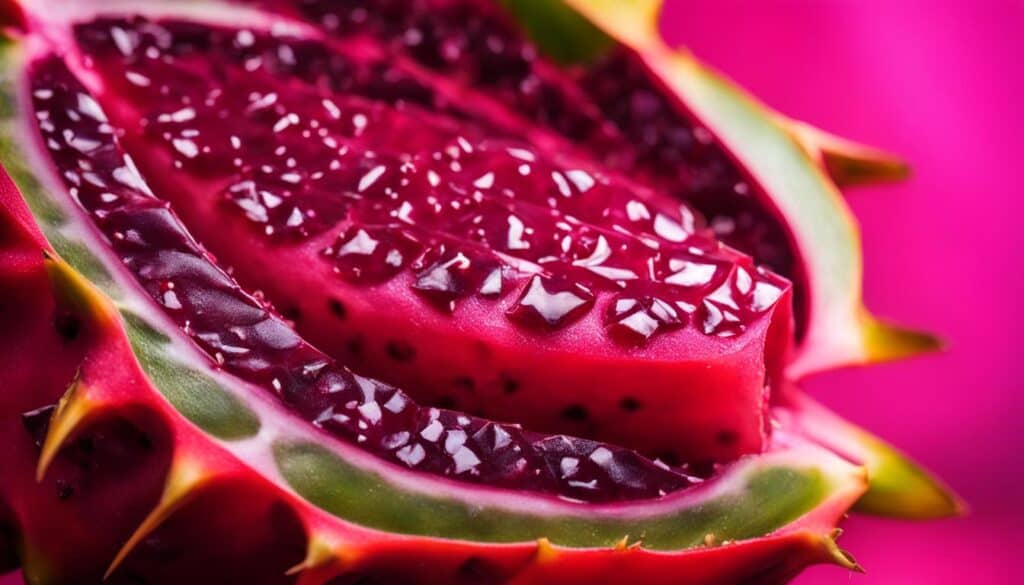
Red Skin/Red Flesh Dragon Fruit Facts
| Appearance | Flavor | Common Uses |
|---|---|---|
| Bright red skin with magenta flesh | Sweeter with a hint of berry taste | Cocktails, popsicles |
As shown in the table above, the red skin/red flesh dragon fruit is not only visually appealing but also offers a sweeter flavor compared to other dragon fruit varieties. Its magenta flesh and vibrant red skin make it a standout ingredient in cocktails and popsicles.
Yellow Skin/White Flesh Dragon Fruit
When it comes to sweetness, the yellow skin/white flesh dragon fruit takes the crown. This variety is known for its intense sweetness and rich flavor, making it the sweetest of all dragon fruit types. Not only is it delicious, but it also has a unique appearance.
The yellow skin/white flesh dragon fruit has almost translucent flesh, giving it a visually appealing quality. Additionally, it has larger seeds compared to other dragon fruit varieties, adding a textural element to every bite.
Grown primarily in Ecuador, this variety has gained popularity among dragon fruit enthusiasts for its exceptional taste and quality. Its vibrant yellow skin makes it a standout among other varieties, inviting you to experience its sweet delight.
To fully enjoy the sweetness of this dragon fruit, it is often consumed fresh. Many people also use it as an ingredient in fruity salsas, adding a burst of flavor to their meals.
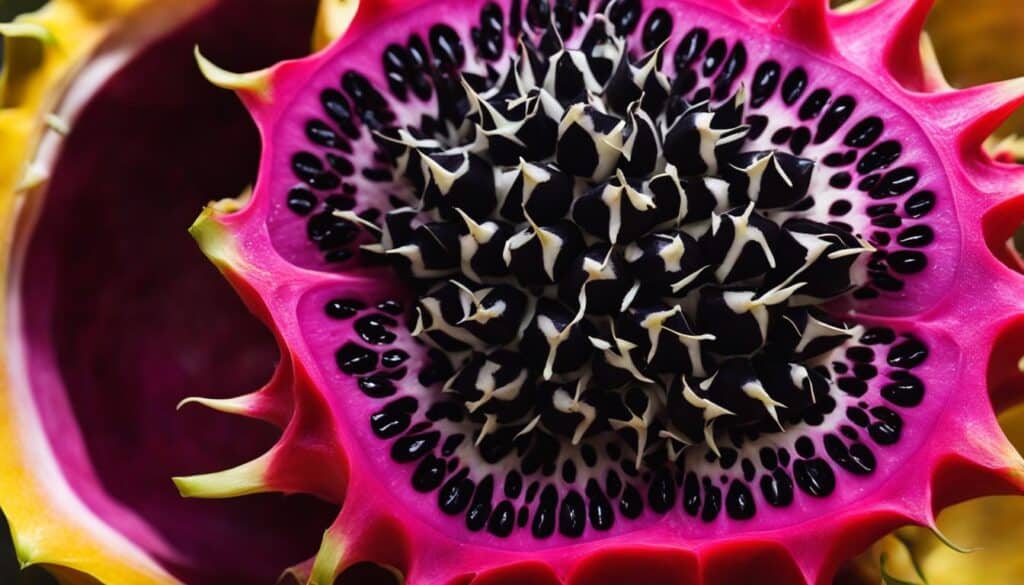
| Traits | Description |
|---|---|
| Skin | Yellow |
| Flesh | White with translucent appearance |
| Seeds | Larger compared to other varieties |
| Flavor | Intense sweetness with a rich taste |
| Origin | Ecuador |
| Popular Uses | Fresh consumption, fruity salsas |
Dragon Fruit vs. Pitaya
When it comes to dragon fruit, you may have heard another name: pitaya. But what’s the difference? Well, the truth is, dragon fruit and pitaya are actually the same fruit! The name pitaya has its origins in Latin American cultures, while the term dragon fruit is more commonly used in Asian markets. Despite the different names, they both refer to the same delicious tropical fruit with various varieties and flavors.
Dragon fruit, or pitaya, is a fruit that is deeply intertwined with Latin American heritage and Asian markets alike. It represents the vibrant and diverse cultures of both regions, becoming a staple in cuisine, beverages, and desserts.
So whether you call it dragon fruit or pitaya, this fruit is a true delight for your taste buds, offering a unique combination of flavors and textures that are sure to leave you craving more.

Now that you know the difference between dragon fruit and pitaya, it’s time to explore the various varieties and flavors this tropical fruit has to offer. Let’s dive into the taste and texture of dragon fruit in the following sections.
Taste and Texture of Dragon Fruit
When ripe, dragon fruit has a mildly sweet flavor that is often described as a blend of pear and kiwi. Its soft texture is similar to that of a ripe kiwi. However, unripe dragon fruit has no flavor at all. The fruit is known for its refreshing taste and creamy texture, which makes it a popular choice for smoothies, fruit salads, and desserts.
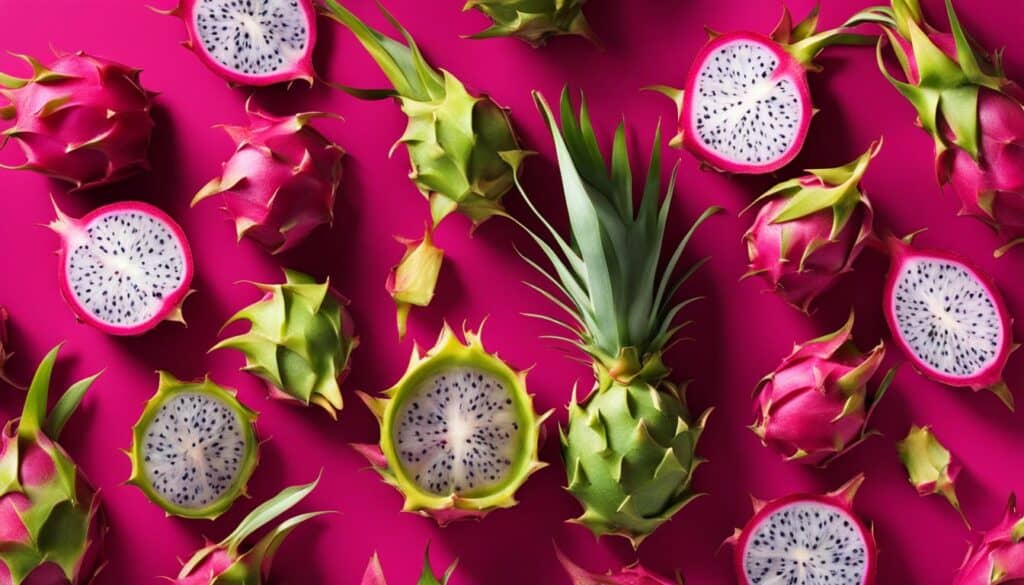
“Dragon fruit has a unique taste that is both delicate and refreshing. The subtly sweet flavor adds a pleasant touch to various dishes and beverages.”
Whether you enjoy it on its own or incorporate it into your favorite recipes, dragon fruit provides a delightful taste experience with its mild sweet flavor and soft texture. Its versatility and appeal make it a favorite among fruit enthusiasts worldwide.
How to Determine Ripeness and Select the Sweetest Dragon Fruit
When it comes to enjoying the sweetest dragon fruit, selecting the ripest ones is key. Here are some tips to help you determine the ripeness of dragon fruit and choose the best sweet dragon fruit:
- Inspect the skin: Look for dragon fruit with bright, even colors on the skin. Avoid fruits with blemishes or dark spots, as these may indicate overripeness.
- Check the texture: Gently press the fruit. A ripe dragon fruit should be slightly malleable but not too soft or mushy.
- Consider the variety: Pink-fleshed dragon fruit is typically sweeter than the white-fleshed variety. If you prefer a sweeter flavor, opt for the pink-fleshed variety.
- Assess the weight: Choose dragon fruit that feels heavy for its size. This indicates juiciness and ripeness.
- Observe the wings: The wings of a ripe dragon fruit will start to dry out and turn yellow with some brown tips. If the wings are green and fresh, the fruit may still need more time to ripen.
Follow these guidelines to ensure you select the sweetest dragon fruit for your enjoyment. Enjoy the vibrant flavors and unique taste of this tropical fruit!
| Signs of Ripeness | Criteria |
|---|---|
| Bright, even-colored skin | Indicates freshness and optimal ripeness |
| Slightly malleable texture | Avoid fruits that are too soft or mushy |
| Pink-fleshed variety | Typically sweeter than the white-fleshed variety |
| Feels heavy for its size | Signifies juiciness and ripeness |
| Drying wings with yellow and brown tips | Indicates a ripe dragon fruit |
By following these tips, you’ll be able to select the ripest and sweetest dragon fruit for a truly delightful taste experience.
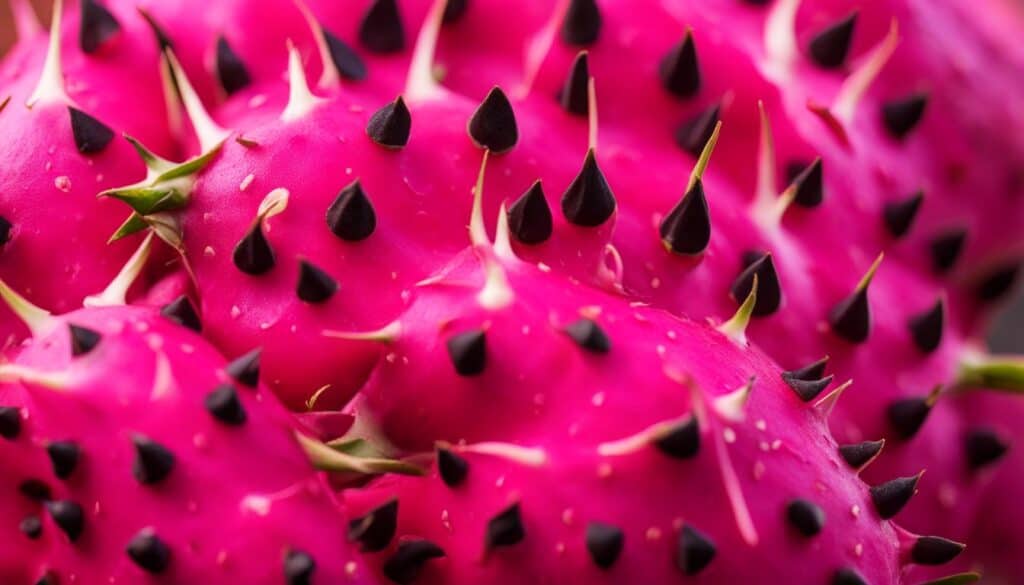
How to Prepare and Eat Dragon Fruit
Nutritional Benefits of Dragon Fruit
Dragon fruit is not only a delicious tropical fruit, but it also offers a wide range of nutritional benefits. Whether you’re looking to enhance your overall health or simply indulge in a tasty treat, dragon fruit has you covered.
One of the standout features of dragon fruit is its high content of prebiotic fiber. This type of fiber is not digested by your body, but it serves as food for the probiotics in your gut. By promoting the growth of beneficial bacteria, dragon fruit can support a healthy digestive system and improve gut health.
Additionally, dragon fruit is a rich source of antioxidants. These powerful compounds, including flavonoids and phenolic acid, help protect your body’s cells from damage caused by free radicals. Antioxidants play a crucial role in reducing inflammation and lowering the risk of chronic diseases.
When it comes to vitamins and minerals, dragon fruit is no slouch. It’s an excellent source of vitamin C, which is essential for a strong immune system and collagen production. Additionally, dragon fruit provides important minerals like iron, magnesium, and calcium, which are vital for maintaining healthy bones, muscles, and overall body function.
| Nutrient | Amount per 100g |
|---|---|
| Prebiotic Fiber | 1.8g |
| Antioxidants | Varies |
| Vitamin C | 9.0mg |
| Iron | 0.65mg |
| Magnesium | 36mg |
| Calcium | 8.8mg |
With its rich nutritional profile, dragon fruit can be a valuable addition to your diet. Whether you enjoy it on its own, add it to smoothies, or incorporate it into various recipes, you can reap the benefits of its prebiotic fiber, antioxidants, vitamins, and minerals.
Conclusion
After exploring the various varieties and flavors of dragon fruit, it’s clear that selecting the sweetest dragon fruit requires attention to certain characteristics. By choosing dragon fruit with bright, even-colored skin, a slightly malleable texture, and a heavy weight, you can ensure a more enjoyable and flavorful experience.
Dragon fruit can be enjoyed in a variety of ways, whether you prefer to eat it raw, sliced, or incorporated into recipes. Its refreshing taste and creamy texture make it a versatile ingredient, perfect for smoothies, fruit salads, salsa, and even grilled dishes. With its high fiber content, antioxidants, and key nutrients, dragon fruit not only satisfies your sweet tooth but also provides important health benefits.
So, the next time you come across this tropical fruit, remember the tips for selecting the sweetest dragon fruit and indulge in its unique flavors and nutritional goodness.
| Characteristics | Description |
|---|---|
| Bright, even-colored skin | Indicates ripeness and flavor |
| Slightly malleable texture | Signifies juiciness and sweetness |
| Heavy weight | Indicates high water content and optimal ripeness |
Further Reading
Looking for more information on dragon fruit? Whether you want to explore delicious dragon fruit recipes, learn fascinating dragon fruit facts, or discover a comprehensive dragon fruit guide, these sources have got you covered:
First Source: Get access to a wide range of mouthwatering dragon fruit recipes that showcase the versatility of this tropical fruit. From smoothies and salads to desserts and main dishes, you’ll find endless inspiration to incorporate dragon fruit into your culinary creations.
Second Source: Dive into the world of dragon fruit facts with this comprehensive resource. Learn about the origins of dragon fruit, its nutritional value, and how to select and prepare the best dragon fruit. Discover interesting trivia and surprising health benefits associated with this exotic fruit.
Third Source: If you’re looking for a complete guide to dragon fruit, this source is your go-to. From different dragon fruit varieties and their unique flavors to tips on ripeness and selection, this guide has all the information you need to become a dragon fruit expert.
FAQ
What is dragon fruit?
Dragon fruit, also known as pitaya, is a tropical cactus fruit that is native to Mexico and Central America. It is a cousin to the cactus pear but does not have any spines or needles on the outer skin. Dragon fruit comes in different varieties with unique flavors and sweetness levels.
Which dragon fruit variety is the least sweet?
The dragon fruit variety with red skin and white flesh is the least sweet among the different dragon fruit varieties. It has an earthy flavor and is often used in fruit salads or as a refreshing snack.
What is the flavor of red skin/red flesh dragon fruit?
Red skin/red flesh dragon fruit has a sweeter flavor compared to the red skin/white flesh variety, with a hint of berry taste. This type of dragon fruit is commonly used in cocktails and popsicles for its vibrant color and sweet flavor.
Which dragon fruit variety is the sweetest?
The yellow skin/white flesh dragon fruit is considered the sweetest variety. It has almost translucent flesh and larger seeds compared to other varieties. This type of dragon fruit is known for its intense sweetness and rich flavor and is often enjoyed fresh or used in fruity salsa.
What is the difference between dragon fruit and pitaya?
Dragon fruit and pitaya are interchangeable names for the same fruit. The name pitaya originated from Latin American cultures, while the term dragon fruit is commonly used in Asian markets. Despite the different names, they both refer to the same tropical fruit with various varieties and flavors.
What does dragon fruit taste like?
When ripe, dragon fruit has a mildly sweet flavor often described as a blend of pear and kiwi. It has a soft texture similar to a ripe kiwi. However, unripe dragon fruit has no flavor at all. The fruit is known for its refreshing taste and creamy texture, which makes it a popular choice for smoothies, fruit salads, and desserts.
How do I determine the ripeness of dragon fruit?
To determine the ripeness of dragon fruit, look for bright, even colors on the skin and fruit that is slightly malleable but not too soft or mushy. Pink-fleshed dragon fruit is typically sweeter than the white-fleshed variety. Choose dragon fruit that feels heavy for its size, indicating juiciness. The wings of a ripe dragon fruit will dry out and turn yellow with some brown tips.
How do I prepare and eat dragon fruit?
To prepare dragon fruit, cut it in half and either eat it directly from the peel or remove the flesh with a spoon. Dragon fruit can be eaten raw, sliced, or used in various recipes. It pairs well with other fruits in smoothies, fruit salads, and salsa. It can also be grilled, used as a garnish for cocktails, or enjoyed in sorbets and desserts.
What are the nutritional benefits of dragon fruit?
Dragon fruit is not only a tasty fruit but also offers several nutritional benefits. It contains prebiotic fiber that promotes gut health and supports the growth of probiotics. It is also rich in antioxidants, including flavonoids and phenolic acid, which help protect the body against free radicals. Dragon fruit is a good source of vitamin C, iron, magnesium, protein, and calcium.
How do I select the sweetest dragon fruit?
To select the sweetest dragon fruit, look for bright, even-colored skin, a slightly malleable texture, and a heavy weight. Pink-fleshed dragon fruit is typically sweeter than the white-fleshed variety. Choose dragon fruit that feels heavy for its size, indicating juiciness. The wings of a ripe dragon fruit will dry out and turn yellow with some brown tips.
Are there any further resources about dragon fruit?
For more information on dragon fruit, including recipes and additional facts, refer to the following sources:
– First Source: (link to the first source)
– Second Source: (link to the second source)
– Third Source: (link to the third source)

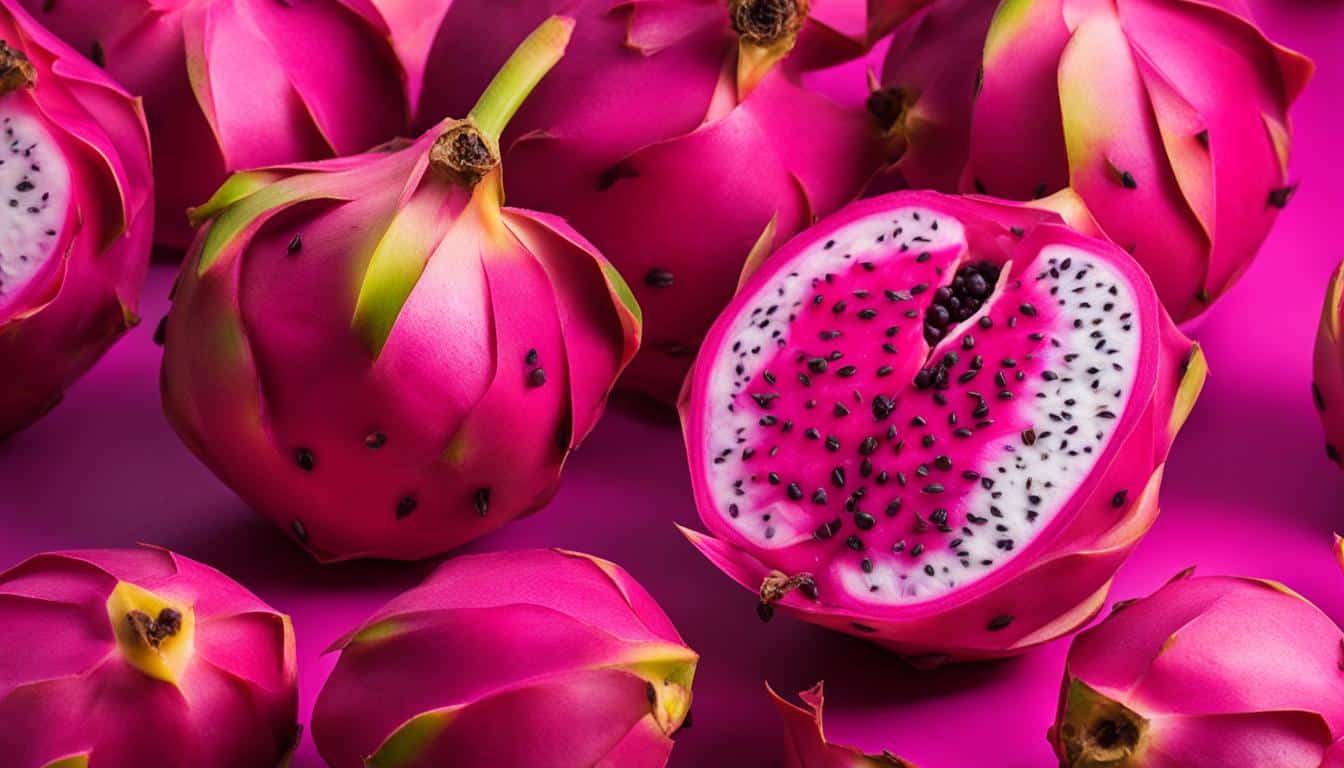



Leave a Reply